27 Mar 2025
BlogOverview
This article provides expert insights and best practices essential for achieving success in sustainable construction services. It underscores the critical need for integrating eco-friendly materials, energy-efficient systems, and effective waste management strategies. Current trends indicate a rising demand for sustainable practices within the construction industry, which collectively contribute to enhanced environmental protection, economic savings, and social responsibility. By adopting these practices, stakeholders can not only meet market expectations but also lead the way in promoting a sustainable future.
Introduction
In an era where environmental consciousness is paramount, the construction industry finds itself at a pivotal crossroads. It grapples with the dual challenge of meeting rising demand while minimising its ecological footprint. Sustainable construction has emerged as a vital approach, emphasising the design, construction, and operation of buildings that prioritise resource efficiency and environmental protection. Given that the construction sector is responsible for a significant portion of global emissions, innovative practices are not merely beneficial, they are essential.
This article delves into the core principles, benefits, challenges, and effective strategies for implementing sustainable construction practices. It offers insights into how the industry can evolve to meet the expectations of clients and stakeholders alike while contributing to a greener future.
Understanding Sustainable Construction: Key Concepts and Definitions
Sustainable construction services are essential for the design, development, and operation of structures that minimise environmental impacts while maximising resource efficiency. This approach has become increasingly vital, as the building sector accounts for approximately 13% of global emissions, highlighting the urgent need for innovative practices that contribute to a low carbon economy.
Key concepts in sustainable construction include:
- Sustainable Design: Integrating eco-friendly materials and energy-efficient systems from the initial design phase is crucial. By prioritising sustainable construction services, developers can significantly reduce the environmental footprint of their projects.
- Lifecycle Assessment (LCA): This critical tool evaluates the environmental impact of a building throughout its entire lifecycle, from material extraction to demolition. Such comprehensive analysis identifies opportunities for reducing waste and enhancing resource efficiency, aligning with Edmond Shipway’s commitment to sustainability consultancy.
- Green Building Standards: Frameworks BREEAM provide guidelines for adopting eco-friendly practices in building. For example, the Microgaming Office in the UK recently achieved a BREEAM certification with an ‘excellent’ rating, showcasing its dedication to eco-friendly practices and reinforcing the importance of such standards in the industry.
Recent trends reveal a growing demand for sustainable construction services, as environmentally friendly solutions gain traction in the construction sector. As Global Newswire highlights, “There has been a growing demand for sustainable construction services and eco-conscious solutions in the non-residential construction market.” This shift challenges the misconception that eco-friendly buildings are prohibitively expensive, particularly as these alternatives become more accessible and affordable.
Supporting this trend is research indicating that working in green office environments can enhance cognitive performance by 61%, leading to improved productivity and well-being for occupants.
Looking ahead to 2025, the emphasis on eco-friendly design and lifecycle evaluation is poised to advance further, focusing on innovative materials and building methods that mitigate climate change. By understanding and applying these key principles, building professionals can contribute to a more sustainable future while meeting the rising expectations of clients and stakeholders.
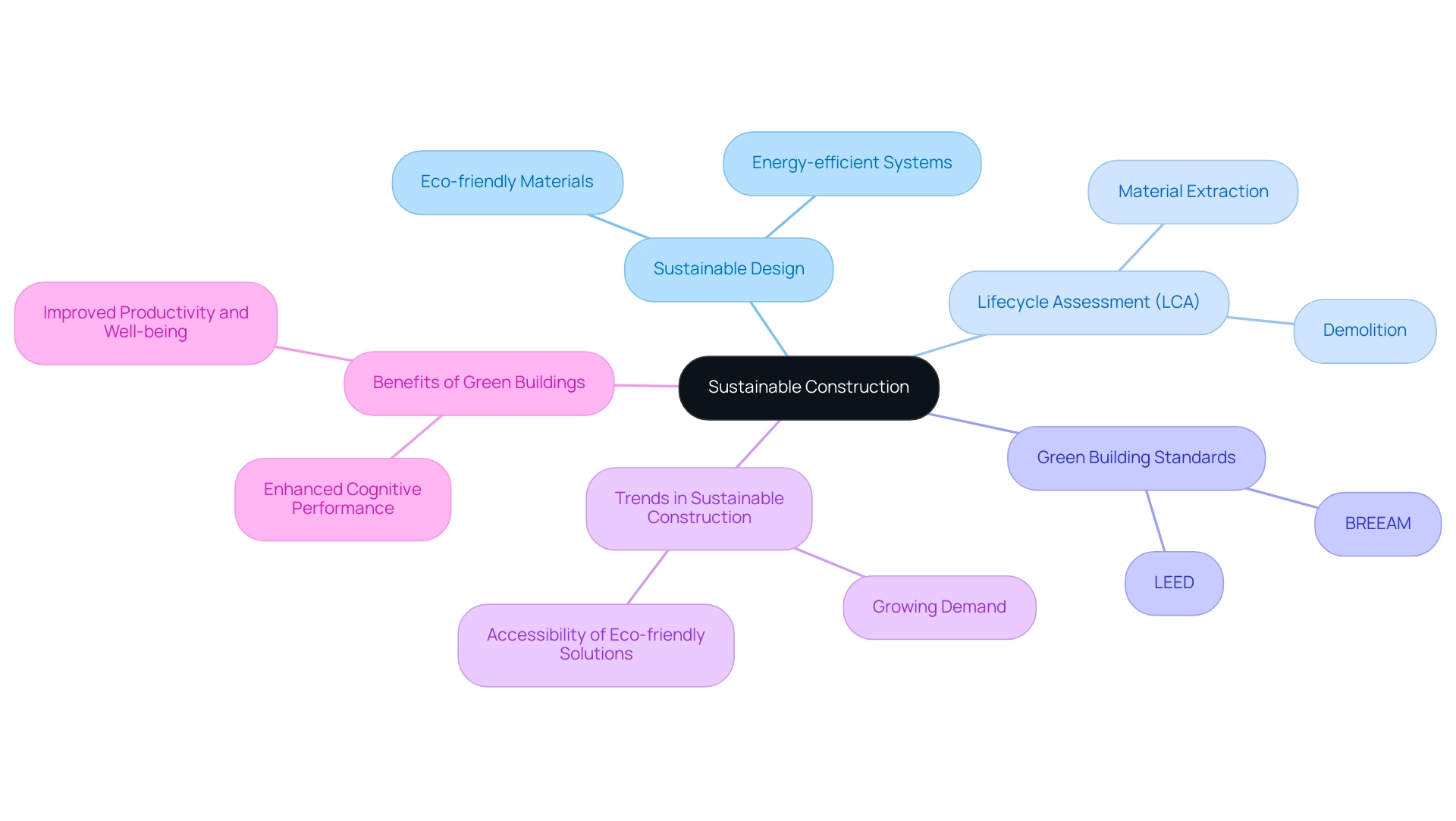
The Importance of Sustainability in Construction: Benefits and Impacts
Sustainability in building presents a wealth of advantages that transcend mere environmental considerations. The key benefits are as follows:
- Environmental Protection: Sustainable practices play a crucial role in significantly reducing carbon footprints. Building activities are responsible for approximately 15% of global greenhouse gas emissions. By adopting eco-friendly materials and methods, the industry can conserve natural resources and mitigate climate change. As the demand for environmentally conscious solutions rises, the perception that green structures are prohibitively expensive is increasingly being challenged.
- Economic Savings: The implementation of eco-friendly practices yields substantial economic benefits. For example, energy-efficient designs and materials can lower operational costs, while waste reduction strategies contribute to overall savings. Options such as eco-friendly concrete and the use of recyclables have been shown to reduce CO emissions by as much as 50%, underscoring the economic viability of green construction initiatives. Nevertheless, 77% of builders cite ‘Lack of Customer Demand’ as the primary obstacle to green building, highlighting the challenges faced in promoting sustainability within the industry.
- Social Responsibility: Beyond financial implications, sustainable practices foster community well-being by creating healthier living environments. Projects that prioritise sustainability often result in improved air quality and reduced health risks, benefits that are increasingly valued by both clients and investors.
These advantages collectively enhance the overall value of development projects, rendering them more attractive to stakeholders. This evolving landscape emphasises the necessity of integrating sustainable construction services into building practices, which is vital for not only environmental protection but also for economic and social advancement. Edmond Shipway, with its comprehensive sustainable construction services, is well-positioned to assist hospitality developers in effectively implementing these eco-friendly practices.
By leveraging our expertise in project management and cost-effectiveness, we can guide clients through the complexities of eco-friendly building, ensuring their projects not only comply with environmental standards but also achieve economic feasibility. There is a growing demand for eco-friendly and environmentally responsible solutions in the non-residential green building market, further highlighting the industry’s need to adapt to these evolving expectations.
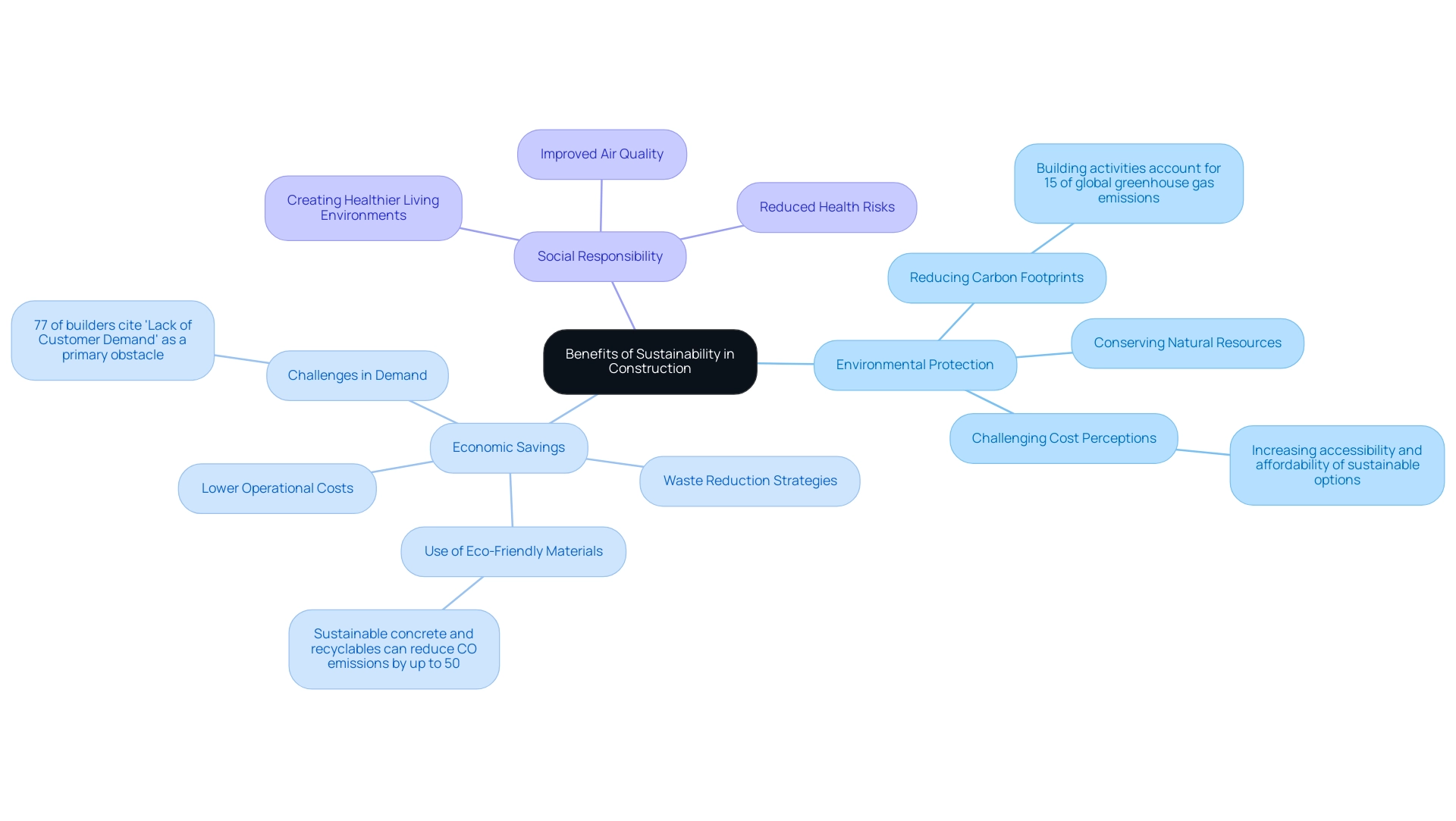
Core Principles of Sustainable Construction: A Framework for Best Practices
The core principles of sustainable construction services are essential for guiding professionals in the industry towards more environmentally responsible practices. These principles include:
- Resource Efficiency: This principle focuses on the optimal use of materials and energy to minimise waste. By adopting innovative methods and technologies, building projects can significantly lower their resource usage. Recent statistics from a survey of 200 building industry professionals indicate that projects emphasising resource efficiency can achieve up to a 30% reduction in material waste, showcasing the tangible benefits of this approach.
- Durability: Creating structures for longevity is essential in sustainable development. Durable structures not only require less frequent repairs and replacements but also contribute to lower lifecycle costs. A case study titled “Defining Sustainable Construction” illustrates that structures designed with durability in mind can endure considerably longer than traditional ones, thereby minimising the overall ecological footprint related to creation and demolition.
- Waste Reduction: Effective waste management strategies are essential throughout the development process and the structure’s lifecycle. Implementing practices such as recycling materials and utilising prefabricated components can lead to substantial waste reduction. For instance, projects that incorporate waste reduction strategies have reported decreases in building waste by as much as 50%, highlighting the importance of this principle.
- Indoor Environmental Quality: Ensuring a healthy indoor environment is paramount for occupant well-being. This involves proper ventilation, the use of non-toxic materials, and maximising natural light. Studies indicate that structures created with an emphasis on indoor environmental quality can improve occupant productivity and satisfaction, further highlighting the necessity for eco-friendly design practices.
These principles not only guide industry professionals in applying environmentally conscious practices but also align with the increasing need for sustainable construction services in the field. As noted, there has been an increased demand for environmentally friendly solutions in the non-residential green building market. As the building environment evolves, recognising and investing in sustainable construction services will be crucial for achieving long-term sustainability and success.
Moreover, the essential requirement for skilled experts educated in eco-friendly building methods highlights the significance of educational initiatives and certifications in preparing the workforce for the sector’s shift towards sustainability.
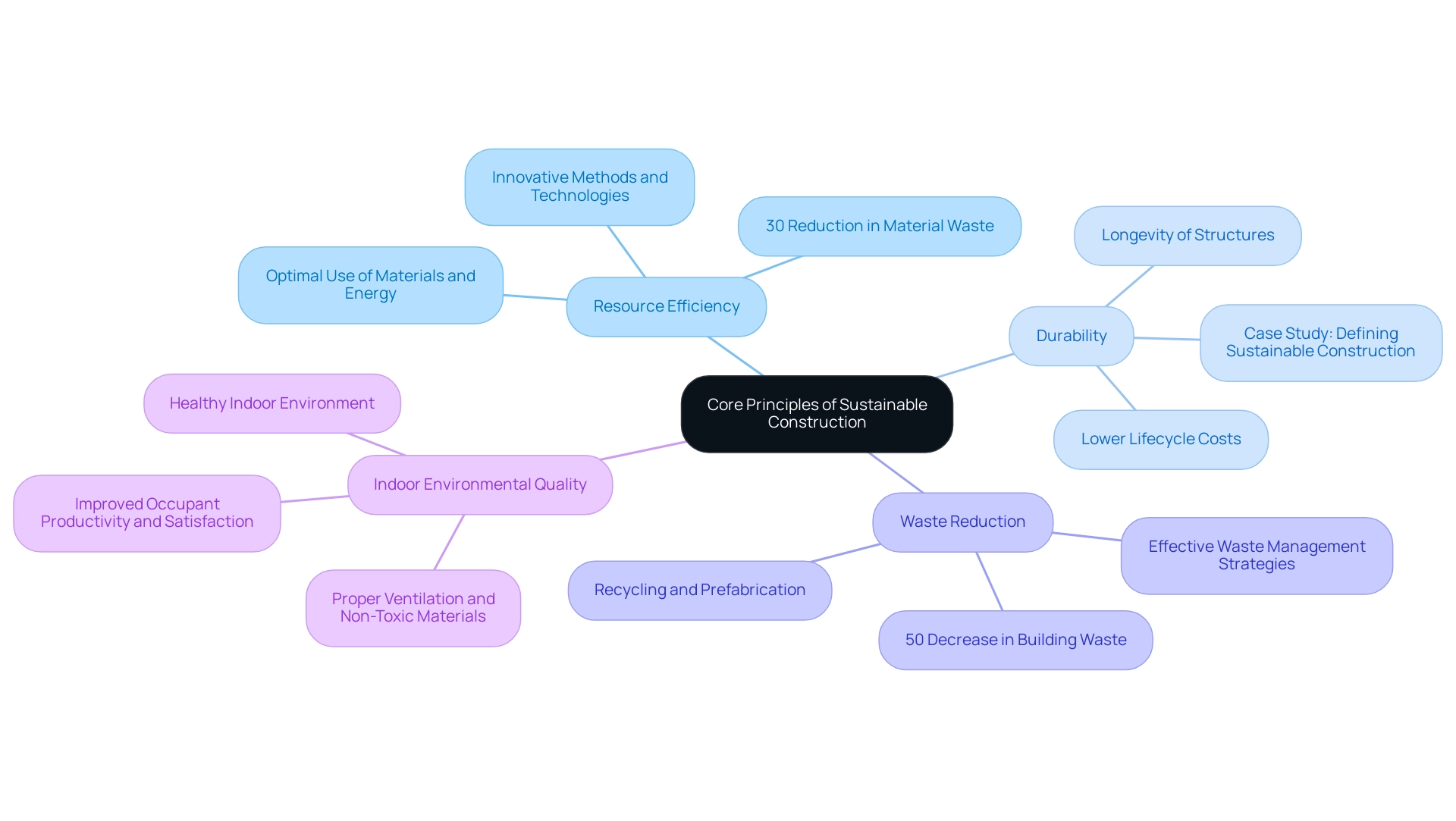
Effective Strategies for Implementing Sustainable Construction Practices
To effectively apply eco-friendly building practices, it is essential to consider several key strategies:
- Use of Eco-Friendly Materials: Prioritise the use of recycled, reclaimed, or locally sourced materials. This approach minimises environmental impact and supports local economies. For instance, steel, a major construction component, can be produced using up to 40% recycled materials, significantly reducing waste while maintaining structural integrity. Furthermore, materials like bamboo can sequester up to 12 tonnes per hectare per year, further emphasising the advantages of eco-friendly sourcing.
- Energy Efficiency Measures: Integrate energy-efficient systems such as LED lighting, high-efficiency HVAC systems, and renewable energy sources. Edmond Shipway’s Mechanical and Electrical Consultancy specialises in building services focused on energy efficiency, helping clients reduce CO2 emissions while lowering energy costs. Implementing these technologies can lead to substantial savings; research indicates that adopting the latest eco-friendly technologies in construction could save £410 billion annually on global energy expenditures. By concentrating on these energy-efficient measures, initiatives can significantly reduce their operational costs and environmental footprint.
- Waste Management Plans: Establish comprehensive waste management strategies that emphasise recycling and reusing materials. Efficient waste management decreases landfill contributions and improves initiative longevity.
- Training and Education: Invest in continuous training for staff on eco-friendly practices and technologies. Empowering teams with knowledge regarding eco-friendly building techniques fosters a culture of sustainability and innovation.
- Management Leadership: Recognise the vital role of managers in guiding initiatives towards environmentally conscious results. Their leadership is essential in ensuring that eco-friendly practices are effectively implemented throughout the project lifecycle.
These strategies not only bolster environmental efforts but also enhance project outcomes and elevate client satisfaction. As the demand for eco-conscious and environmentally friendly solutions continues to rise, the building sector must adapt to fulfil these expectations by offering sustainable construction services that ensure green practices are both attainable and beneficial. Edmond Shipway is committed to achieving Net Zero Carbon targets, underscoring the increasing need for eco-conscious and environmentally friendly solutions in the non-residential green structure market, reflecting the evolving perspective on eco-friendly development.
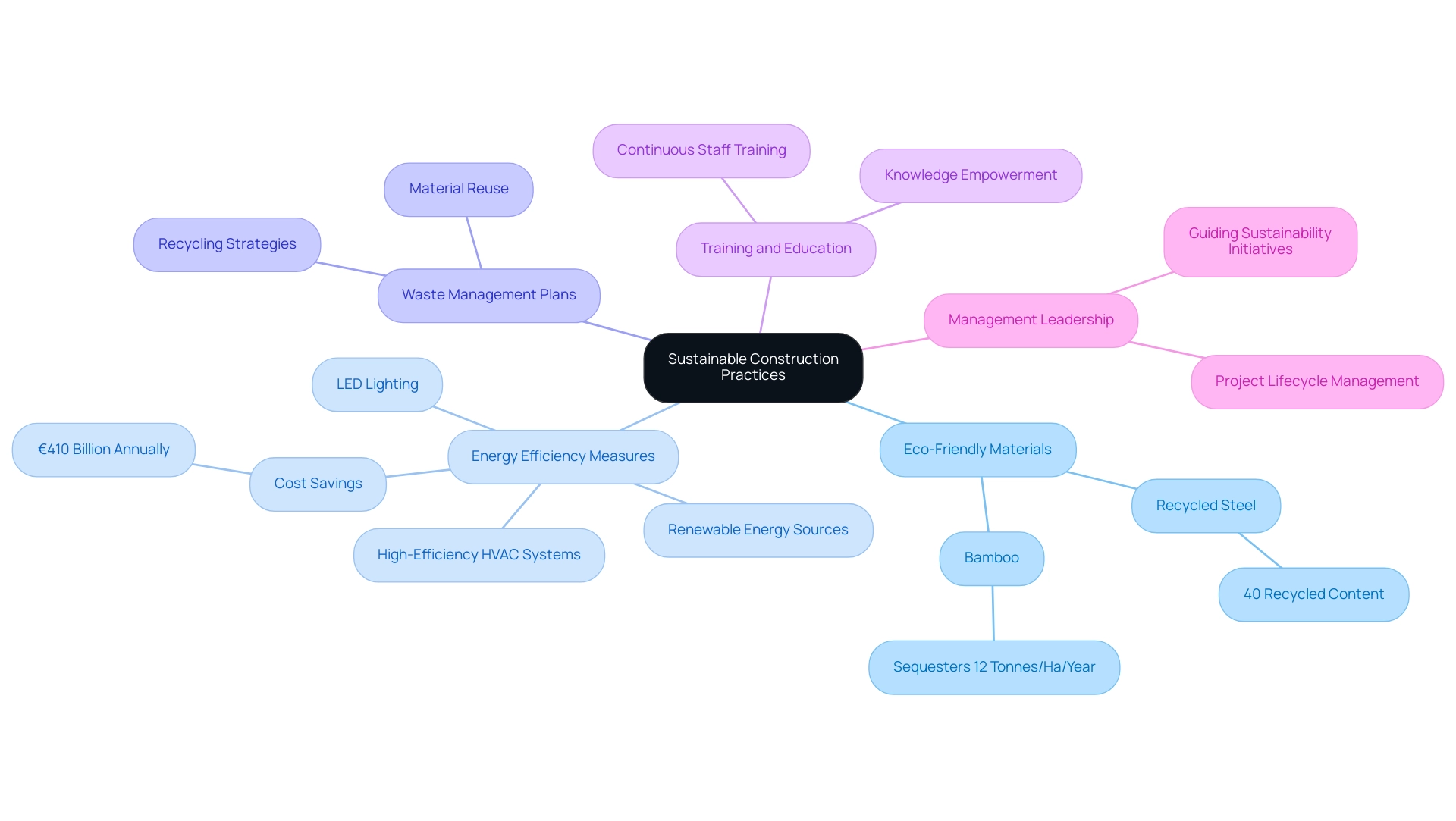
Navigating Challenges in Sustainable Construction: Solutions and Strategies
Challenges in sustainable construction encompass several critical areas that require careful consideration:
- Higher Initial Costs: While sustainable materials and technologies often come with elevated upfront expenses, they frequently result in significant long-term savings. For instance, structures with sustainable designs can lead to operating costs that are 15% lower than conventional office spaces, showcasing the financial viability of eco-friendly investments.
- Regulatory Hurdles: The complexity of navigating building codes and regulations can pose significant challenges. Careful planning and adherence to these codes are essential to ensure success. Staying informed and actively engaging with local authorities is crucial to facilitate smoother project execution. As the demand for eco-friendly building solutions grows, understanding these regulations becomes increasingly important.
- Knowledge Gaps: A well-informed team is crucial for the successful execution of eco-friendly practices. Ensuring that all team members are knowledgeable about the latest eco-friendly technologies and methods can close knowledge gaps and improve results.
To effectively address these challenges, several solutions can be implemented:
- Budgeting for Sustainability: It is vital to allocate specific funds for sustainable practices within project budgets. This proactive approach not only prepares teams for the initial costs associated with eco-friendly materials but also emphasises the long-term benefits of such investments.
- Stakeholder Engagement: Involving all stakeholders early in the process fosters collaboration and addresses concerns related to sustainability. This involvement can result in innovative solutions and a collective dedication to eco-friendly practices. Furthermore, numerous suppliers now offer eco-friendly product lines, and online directories can assist in locating verified eco-friendly material providers, offering practical resources for teams.
By proactively tackling these challenges, building teams can significantly enhance their sustainable construction services, ultimately contributing to a more eco-friendly built environment. The expanding market for eco-friendly building solutions, anticipated to attain £99.8 billion by 2025, indicates a change in viewpoint concerning the expenses and advantages of green building, thereby making sustainable construction services an increasingly feasible choice for developers.
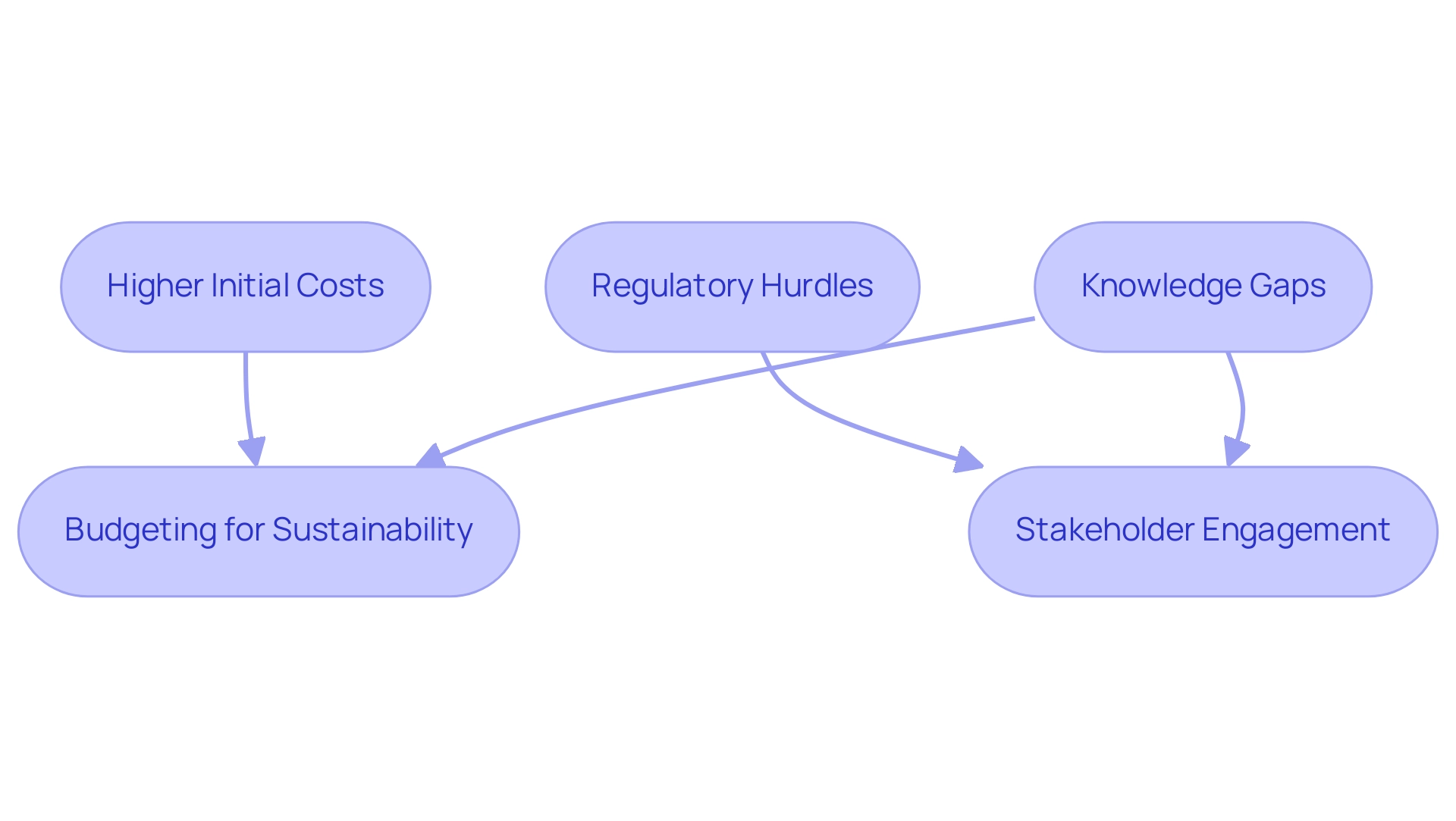
Leveraging Technology for Sustainable Construction: Innovations and Tools
Technology plays a pivotal role in advancing sustainable construction practices, with several key innovations leading the charge:
- Building Information Modelling (BIM): This powerful tool significantly enhances project planning and collaboration, effectively reducing waste and improving overall efficiency. Research indicates that elevating the usage of BIM by just one level can boost project performance by approximately 0.645, highlighting its profound impact on efficiency in construction. A notable case study, “Impact of Building Information Modelling (BIM) in Construction Management,” illustrates BIM’s capability to create comprehensive models that support the entire lifecycle of a building, thereby demonstrating its effectiveness in enhancing construction management.
- Smart Building Technologies: By integrating Internet of Things (IoT) devices, these technologies facilitate real-time monitoring of energy consumption and environmental conditions. This functionality not only optimises resource use but also fosters a more sustainable operational model.
- Sustainable Construction Services: These specialised tools assist teams in tracking resource utilisation, managing waste, and analysing the sustainability of materials. They play a crucial role in ensuring adherence to sustainability standards while maximising efficiency.
As we move toward 2025, the emphasis on technological innovations in sustainable construction services continues to intensify, particularly regarding smart building technologies. These advancements not only support sustainability objectives but also enhance outcomes, making sustainable construction services essential for contemporary building practices. By leveraging these technologies, building teams can significantly elevate their sustainability initiatives and achieve outstanding results.
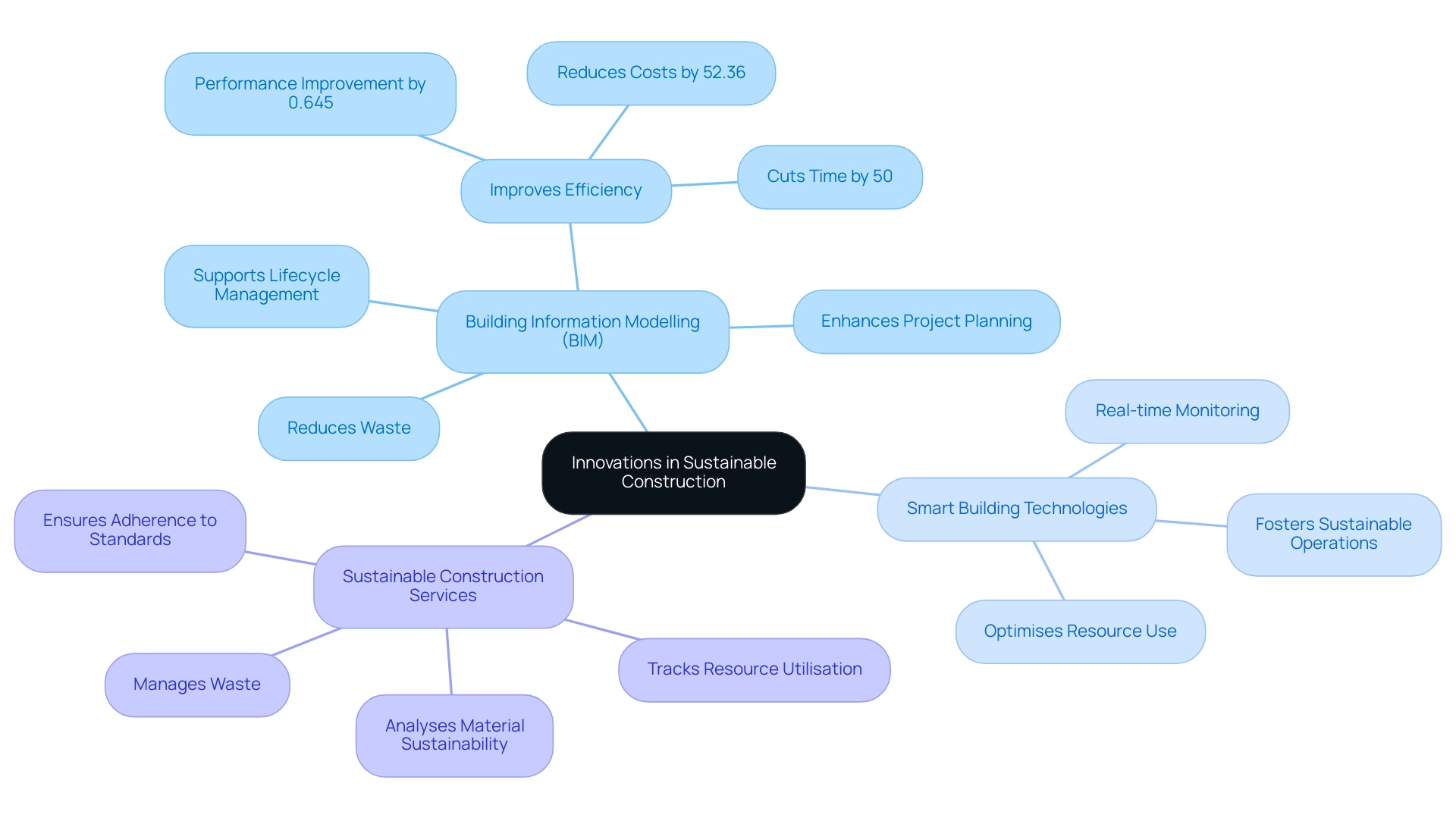
Engaging Stakeholders in Sustainable Construction: Best Practices for Collaboration
Engaging stakeholders effectively is paramount in sustainable construction and involves several key practices:
- Identifying Key Stakeholders: Recognising all parties affected by the project is essential. This includes not only direct participants but also community members and regulatory bodies. Involving these stakeholders early in the planning process ensures their insights and concerns are integrated into development.
- Open Communication: Transparent communication is crucial for building trust among stakeholders. Regular updates and open channels for feedback help address concerns proactively, fostering a collaborative environment. Research indicates that effective communication can significantly reduce misunderstandings and enhance alignment.
- Collaborative Decision-Making: Engaging stakeholders in critical decisions ensures that diverse perspectives are considered, leading to more robust solutions. This collaborative approach not only enhances stakeholder satisfaction but also contributes to the overall success of the initiative. A case study titled “Engagement of the Stakeholders as Critical Success Factor for Infrastructure Initiatives” illustrates that timely involvement of stakeholders in planning and execution is linked to improved quality and outcomes. The findings underscore that effective stakeholder engagement strategies, including consultation and collaboration, are essential for success.
By prioritising these engagement strategies, building teams can enhance collaboration, mitigate risks, and ultimately improve results. The focus on stakeholder involvement is not merely a best practice; it is a vital success element in managing the intricacies of sustainable construction services. As one contractor noted, “…all this has a feedback loop, the engagement depends on the recipient (of the engagement) and not only on the one who engages…” This highlights the dynamic nature of stakeholder interactions and the importance of considering all perspectives.
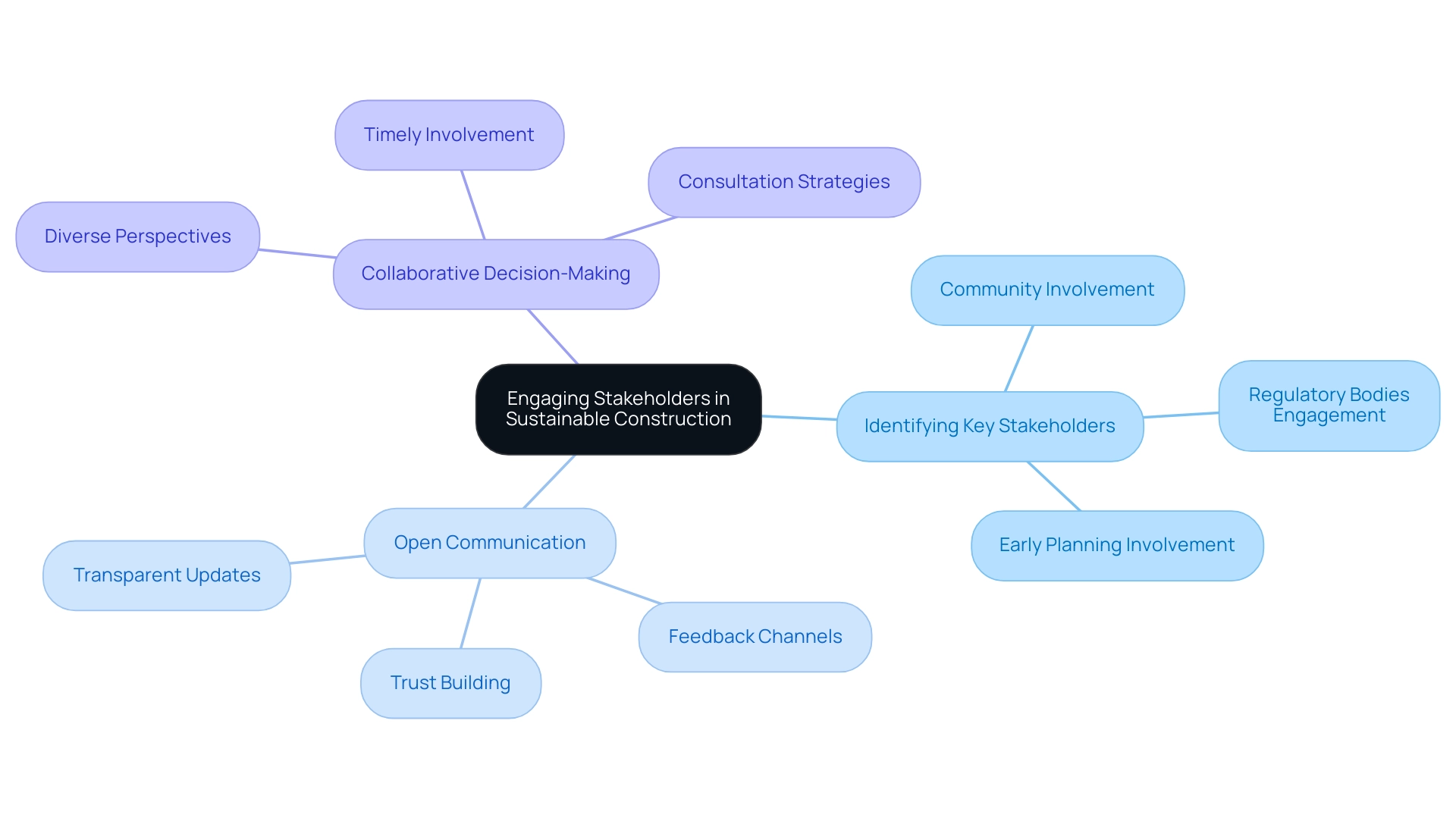
Conclusion
Sustainable construction has evolved from a niche approach to a fundamental necessity within the industry, as this article has demonstrated. By prioritising key principles such as resource efficiency, durability, and waste reduction, construction professionals can significantly mitigate the environmental impacts of their projects. The integration of innovative technologies and materials not only enhances building sustainability but also provides long-term economic benefits, illustrating that eco-friendly practices can align seamlessly with financial viability.
However, challenges such as higher initial costs and regulatory hurdles often impede the adoption of sustainable construction practices. These obstacles can be effectively navigated through strategic planning, stakeholder engagement, and ongoing education. As the demand for sustainable solutions continues to grow, it is imperative for the construction industry to adapt and embrace these changes, ensuring that sustainability becomes the standard rather than the exception.
Ultimately, the journey toward sustainable construction is a collective effort that necessitates collaboration among stakeholders, innovative design, and a commitment to continuous improvement. By prioritising sustainability, the construction industry can not only meet the expectations of clients and investors but also contribute meaningfully to a greener future. The path forward is clear: embracing sustainable practices is essential for fostering a built environment that is not only efficient and cost-effective but also respectful of our planet and its resources.
Share


